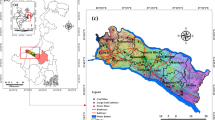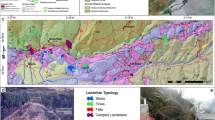Abstract
In comparison to urban or suburban areas, agricultural lands generally have a lower landslide risk. This does not necessarily reflect a lower degree of landslide hazard. The lower risk is more often due to the sparser population and lower property values of rural areas. Population and property values influence methods applicable to assessing landslide hazard in rural areas. The cost of data and size of areas over which assessments must be made for agricultural lands render many assessment procedures uneconomic. Their use is only justified in populous, high-value areas. Many agricultural practices may have the same potential for initiating landslide activity recognized for some land uses in urban areas. Like their urban counterparts, residents dependant onagriculture for their livelihood suffer from the consequences of landslides. For these reasons, a method for landslide hazard assessment suitable for rural areas is needed. This need is satisfied by isopleth mapping of landslides. Isopleth mapping provides an economical means for assessing the degree of landslide hazard present within a large area. Data needs are limited to topographic and landslide maps. Isopleth maps facilitate comparison of landslide data to other information for developing a better understanding of how agricultural practices affect landslide activity. Their use in the Tuscany region of Italy provide insight on how changing agricultural practices altered landslide activity. Isopleth maps serve as a simple way to accomplish landslide hazard zonation. Landslide hazard zonation identifies locations where land use controls should be applied to achieve hazard reduction. Hazard reduction based on isopleth mapping is illustrated by their use in timber sale planning in California, USA.
Résumé
Comparés aux régions urbaines, les territoires agricoles présentent généralement moins de risques de glissements de terrain. Cela ne veut pas nécessairement dire que le degré de risque de glissement de terrain pour les zones agricoles est inférieur. Le risque plus réduit est dû au fait que, dans les régions agricoles, il y a une population plus éparse et le sol coûte moins cher. La population et la valeur de la propriété influencent les méthodes applicables pour l'évaluation du risque de glissement de terrain dans les régions rurales. Ainsi, le coût du recueil des données et la dimension des zones agricoles concernées rendent beaucoup des méthodes d'évaluation des risques de glissements de terrain non économiques. Les méthodes sont justifiées seulement dans les régions peuplées et où la valeur des terrains est élevée. Or, plusieurs pratiques agricoles ont le même potentiel pour provoquer des glissements de terrain que les pratiques d'utilisation du territoire dans les régions urbaines. Certainement, les résidences des zones agricoles souffrent aussi des effets des glissements de terrain. Pour ces raisons, il y a besoin d'une méthode pour évaluer le risque de glissement de terrain dans les régions rurales. Ce besoin est satisfait par la cartographie isoplète des glissements de terrain. La cartographie isoplète est un moyen économique pour l'évaluation du degré de risque dans une région étendue. Pour faire des cartes isoplètes on a seulement besoin des cartes topographiques et des cartes des glissements de terrain. Les cartes isoplètes rendent plus facile une comparaison entre les informations sur les glissements de terrain et d'autres informations pour mieux comprendre comment les pratiques agricoles ont affecté l'activité des glissements de terrain. L'emploi des cartes isoplètes dans la région de Toscane en Italie donne une idée de la façon dont le changement des pratiques agricoles a influencé l'activité des glissements de terrain. Les cartes isoplètes sont une méthode simple pour identifier les risques de glissements de terrain dans certaines zones. Ainsi, on peut préciser les emplacements où il faut réaliser des contrôles sur l'utilisation du sol pour abaisser le degré de risque. La réduction des risques apportée par la cartographie isoplète est illustrée par l'⫲tilisation des cartes isoplètes dans la planification des ventes de bois de construction en Californie, U.S.A.
Similar content being viewed by others
References
BRABB E.E., 1984: Innovative approaches to landslide hazard and risk mapping. IV International Symp. on Landslides, Toronto, Canada, Proc. V. 1: 307–323.
CAMPBELL R.H., 1973: Isopleth map of landslide deposits, Point Dume quadrangle, Los Angeles County, California; an experiment in generalizing and quantifying areal distribution of landslides. U.S. Geo. Surv. Misc. Field Investigations Map MF-535.
CAMPBELL R.H., 1980: Landslide map showing field classification, Point Dume quadrangle, California. U.S. Geol. Surv. Misc. Field Investigation Map MF-1167.
CANUTI P., PRANZINI G. and SESTINI G., 1966: Provenienza ed ambiente di sedimentazione di ciottolami del Pliocene di S. Casciano (Firenze). Memorie della Societa Geologica Italiana, 5: 340–364.
CANUTI P., FOCARDI P., GARZONIO C.A., RODOLFI G. and VANNOCCI P., 1982: Stabilita dei versanti nell'area rappresentativa di Montespertoli (Firenze), Instituto di Geologie e Paleontologia, Universita degli studi de Firenze, Map Scale, 1: 10,000.
CANUTI P., FOCARDI P., GARZONIO C.A., RODOLFI G. and VANNOCCI P., 1985: Slope stability mapping in Tuscany, Italy. First International Conference on Geomorphology, Manchester, England, Proceedings (in press).
DeGRAFF J.V., 1985: Using isopleth maps of landslide deposits as a tool in timber sale planning, Bull. Assoc. Eng. Geol., 22: 445–453.
FLEMING R.W., VARNES D.J., and SCHUSTER R.L., 1979: Landslide hazards and their reduction, Jour. Amer. Planning Assoc., 45: 428–439.
HAYS W.H., SCHUSTER R.L., NEUMANN H.D. and HARROD G.W., 1982: Active landslides on the White Bluffs of the Columbia River, south-central Washington. Geol. Soc. Amer. Abstracts with Programs, 14: 171–172.
MAHR T. and MALGOT J., 1985: Devastation of the environment by landslides activated by construction. Bull. Int. Assoc. Eng. Geol., 31: 82–88.
MILES D.W.R., SWANSON F.J., and YOUNGBERG C.T., 1984: Effects of landslide erosion on subsequent Douglas-fir growth and stocking levels in the western Cascades, Oregon. Soil Sci. Soc. Amer. Jour., 48: 667–671.
POMEROY J.S., 1978: Isopleth maps of landslide deposits, Washington County, Pennsylvania—a guide to comparative slope stability. U.S. Geol. Surv. Misc. field Investigation Map MF-1010.
O'LOUGHLIN C.L. and PEARCE A.J., 1976: Influence of Cenozoic geology on mass movement and sediment yield response to forest removal, North Westland, New Zealand: Bull. Int. Assoc. Eng. Geol., N. 14: 41–46.
SWANSON F.J. and DYRNESS C.T., 1974: Impact of clear-cutting and road construction on soil erosion by landslides in the western Cascade Range. Oregon. Geology, 3: 393–396.
SWANSTON D.N. and SWANSON F.J., 1976: Timber harvesting, mass erosion, and steepland forest geomorphology in the Pacific Northwest, In Dr. R. Coates (ed.), Geomorphology and Engineering. Dowden, Hutchinson & Ross, Stroudsburg, Pa., p. 199–221.
VARNES D.J., 1985: Landslide hazard zonation: a review of principles and practices. UNESCO Natural Hazards Series, N. 3, 116 p.
WRIGHT R.H. and NILSEN T.H., 1974: Isopleth maps of landslides deposits, southern San Francisco Bay Region, California. U.S. Geol. Surv. Field Studies Map MF-550.
WRIGHT, R.H., CAMPBELL, R.H., and NILSEN, T.H., 1974: Preparation and use of isopleth maps of landslide deposits. Geology, 2: 483–485.
Author information
Authors and Affiliations
Rights and permissions
About this article
Cite this article
DeGraff, J.V., Canuti, P. Using isopleth mapping to evaluate landslide activity in relation to agricultural practices. Bulletin of the International Association of Engineering Geology 38, 61–71 (1988). https://doi.org/10.1007/BF02590449
Published:
Issue Date:
DOI: https://doi.org/10.1007/BF02590449




